The Effect of Polymer Waste Addition on the Compressive Strength and Water Absorption of Geopolymer Ceramics
Abstract
1. Introduction
2. Materials and Methods
2.1. Geopolymer Ceramics Composite
2.2. Compressive Strength
- σ is the compressive strength (MPa),
- F is the force (N) applied and A (mm2) is the area of sample.
2.3. Water Absorption (WA)
- M1 is mass of the dry sample, in (g)
- M2 is mass of the wet sample, in (g)
2.4. Characterization
3. Result and Discussion
3.1. Chemical Analysis: X-Ray Fluorescence Spectroscopy
3.2. Effect of LDPE on Microstructure of Geopolymer Ceramics
3.3. FTIR Spectra
3.4. X-Ray Diffraction
3.5. Effect of LDPE particles on Compressive Strength
- ∆σ is a measure of the effect of LDPE addition to compressive strength
- σo is Compressive strength of geopolymer/LDPE composite
- σoo is Compressive strength of geopolymer or control sample
- is the composite strength;
- is the matrix volume fraction;
- is the matrix strength;
- is particle volume fraction;
- is the particle strength.
3.6. Water Absorption Calculation
4. Conclusions
Author Contributions
Funding
Institutional Review Board Statement
Data Availability Statement
Conflicts of Interest
References
- Ameer, Z.A.; Ehood, H.S. Preparation and properties of Biodegradable Blend from LDPE/PVA Mixture. Aust. J. Basic Appl. Sci. 2016, 10, 102–111. [Google Scholar]
- Verma, R.; Vinoda, K.; Papireddy, M.; Gowda, A. Toxic pollutants from plastic waste-a review. Procedia Environ. Sci. 2016, 35, 701–708. [Google Scholar] [CrossRef]
- Ouiminga, S.K.; Rogaume, T.; Daho, T.; Yonli, A.H.; Koulidiati, J. Reductive and oxidative combustion of polyethylene bags: Characterization of carbonaceous and nitrogenous species. J. Anal. Appl. Pyrolysis 2012, 98, 72–78. [Google Scholar] [CrossRef]
- Kumari, K.; Kumar, S.; Rajagopal, V.; Khare, A.; Kumar, R. Emission from open burning of municipal solid waste in India. Environ. Technol. 2019, 40, 2201–2214. [Google Scholar] [CrossRef]
- Klemeš, J.J.; Fan, Y.V.; Tan, R.R.; Jiang, P. Minimising the present and future plastic waste, energy and environmental footprints related to COVID-19. Renew. Sustain. Energy Rev. 2020, 127, 109883. [Google Scholar] [CrossRef]
- Edoga, M.; Onyeji, L.; Oguntosin, O. Achieving vision 20: 2020 through waste produce candle. J. Eng. Appl. Sci. 2008, 3, 642–646. [Google Scholar]
- Azeko, S.T.; Mustapha, K.; Annan, E.; Odusanya, O.S.; Soboyejo, W.O. Recycling of polyethylene into strong and tough earth-based composite building materials. J. Mater. Civ. Eng. 2016, 28, 04015104. [Google Scholar] [CrossRef]
- Galvão, J.C.A.; Portella, K.F.; Joukoski, A.; Mendes, R.; Ferreira, E.S. Use of waste polymers in concrete for repair of dam hydraulic surfaces. Constr. Build. Mater. 2011, 25, 1049–1055. [Google Scholar] [CrossRef]
- Ma, C.-K.; Awang, A.Z.; Omar, W. Structural and material performance of geopolymer concrete: A review. Constr. Build. Mater. 2018, 186, 90–102. [Google Scholar] [CrossRef]
- Ghadir, P.; Ranjbar, N. Clayey soil stabilization using geopolymer and Portland cement. Constr. Build. Mater. 2018, 188, 361–371. [Google Scholar] [CrossRef]
- Le Chi, H.; Louda, P.; Periyasamy, A.P.; Bakalova, T.; Kovacic, V. Flexural behavior of carbon textile-reinforced geopolymer composite thin plate. Fibers 2018, 6, 87. [Google Scholar] [CrossRef]
- Hassan, A.; Ismail, N.; Mourad, A.-H.I.; Rashid, Y.; Laghari, M.S. Preparation and characterization of expanded clay-paraffin wax-geo-polymer composite material. Materials 2018, 11, 2191. [Google Scholar] [CrossRef]
- Korniejenko, K.; Lin, W.-T.; Šimonová, H. Mechanical properties of short polymer fiber-reinforced geopolymer composites. J. Compos. Sci. 2020, 4, 128. [Google Scholar] [CrossRef]
- Hájková, P. Kaolinite claystone-based geopolymer materials: Effect of chemical composition and curing conditions. Minerals 2018, 8, 444. [Google Scholar] [CrossRef]
- Sun, Q.; Tian, S.; Sun, Q.; Li, B.; Cai, C.; Xia, Y.; Wei, Y.; Mu, Q. Preparation and microstructure of fly ash geopolymer paste backfill material. J. Clean. Prod. 2019, 225, 376–390. [Google Scholar] [CrossRef]
- Xie, J.; Wang, J.; Rao, R.; Wang, C.; Fang, C. Effects of combined usage of GGBS and fly ash on workability and mechanical properties of alkali activated geopolymer concrete with recycled aggregate. Compos. Part B Eng. 2019, 164, 179–190. [Google Scholar] [CrossRef]
- Davidovits, J. Geopolymer Chemistry and Applications, 4th ed.; Geopolymer Institute: Saint-Quentin, France, 2015. [Google Scholar]
- Safari, Z.; Kurda, R.; Al-Hadad, B.; Mahmood, F.; Tapan, M. Mechanical characteristics of pumice-based geopolymer paste. Resour. Conserv. Recycl. 2020, 162, 105055. [Google Scholar] [CrossRef]
- Heah, C.Y.; Kamarudin, H.; Mustafa AlBakri, A.M.; Binhussain, M.; Luqman, M.; Khairul Nizar, I.; Ruzaidi, C.M.; Liew, Y.M. Effect of curing profile on kaolin-based geopolymers. Phys. Procedia 2011, 22, 305–311. [Google Scholar] [CrossRef]
- Korniejenko, K.; Tyliszczak, B.; Łach, M.; Mikuła, J.; Hebdowska-Krupa, M.; Mierzwiński, D. Organic Polymers Reinforced Inorganic Polymers-An Overview. In IOP Conference Series: Materials Science and Engineering; IOP Publishing: Bristol, UK, 2018; Volume 416, p. 012090. [Google Scholar]
- Perera, D.; Uchida, O.; Vance, E.; Finnie, K. Influence of curing schedule on the integrity of geopolymers. J. Mater. Sci. 2007, 42, 3099–3106. [Google Scholar] [CrossRef]
- Aredes, F.; Campos, T.; Machado, J.; Sakane, K.; Thim, G.; Brunelli, D. Effect of cure temperature on the formation of metakaolinite-based geopolymer. Ceram. Int. 2015, 41, 7302–7311. [Google Scholar] [CrossRef]
- Carreño-Gallardo, C.; Tejeda-Ochoa, A.; Perez-Ordonez, O.I.; Ledezma-Sillas, J.E.; Lardizabal-Gutierrez, D.; Prieto-Gomez, C.; Valenzuela-Grado, J.A.; Hernandez, F.C.R.; Herrera-Ramirez, J.M. In the CO2 emission remediation by means of alternative geopolymers as substitutes for cements. J. Environ. Chem. Eng. 2018, 6, 4878–4884. [Google Scholar] [CrossRef]
- Lopes, A.V.; Lopes, S.M.; Pinto, I. Influence of the Composition of the Activator on Mechanical Characteristics of a Geopolymer. Appl. Sci. 2020, 10, 3349. [Google Scholar] [CrossRef]
- Samarakoon, M.; Ranjith, P.; Duan, W.H.; de Silva, V. Properties of one-part fly ash/slag-based binders activated by thermally-treated waste glass/NaOH blends: A comparative study. Cem. Concr. Compos. 2020, 112, 103679. [Google Scholar] [CrossRef]
- Rao, F.; Liu, Q. Geopolymerization and its potential application in mine tailings consolidation: A review. Miner. Process. Extr. Metall. Rev. 2015, 36, 399–409. [Google Scholar] [CrossRef]
- Zhou, W.; Yan, C.; Duan, P.; Liu, Y.; Zhang, Z.; Qiu, X.; Li, D. A comparative study of high-and low-Al2O3 fly ash based-geopolymers: The role of mix proportion factors and curing temperature. Mater. Des. 2016, 95, 63–74. [Google Scholar] [CrossRef]
- Duan, P.; Yan, C.; Zhou, W.; Luo, W.; Shen, C. An investigation of the microstructure and durability of a fluidized bed fly ash–metakaolin geopolymer after heat and acid exposure. Mater. Des. 2015, 74, 125–137. [Google Scholar] [CrossRef]
- Duxson, P.; Fernández-Jiménez, A.; Provis, J.L.; Lukey, G.C.; Palomo, A.; van Deventer, J.S. Geopolymer technology: The current state of the art. J. Mater. Sci. 2007, 42, 2917–2933. [Google Scholar] [CrossRef]
- Rattanasak, U.; Chindaprasirt, P. Influence of NaOH solution on the synthesis of fly ash geopolymer. Miner. Eng. 2009, 22, 1073–1078. [Google Scholar] [CrossRef]
- Wang, H.; Li, H.; Yan, F. Synthesis and mechanical properties of metakaolinite-based geopolymer. Colloids Surf. A Physicochem. Eng. Asp. 2005, 268, 1–6. [Google Scholar] [CrossRef]
- Shriram, H.; Mohitkar, V.; Ravi, K. Effect of metakaolin on fresh and hardened propertios of self compacting concrete. Int. J. Civ. Eng. Technol. 2014, 5, 137–145. [Google Scholar]
- He, J.; Zhang, J.; Yu, Y.; Zhang, G. The strength and microstructure of two geopolymers derived from metakaolin and red mud-fly ash admixture: A comparative study. Constr. Build. Mater. 2012, 30, 80–91. [Google Scholar] [CrossRef]
- Assaedi, H.; Shaikh, F.; Low, I.M. Effect of nano-clay on mechanical and thermal properties of geopolymer. J. Asian Ceram. Soc. 2016, 4, 19–28. [Google Scholar] [CrossRef]
- Sakulich, A.R. Reinforced geopolymer composites for enhanced material greenness and durability. Sustain. Cities Soc. 2011, 1, 195–210. [Google Scholar] [CrossRef]
- Kubba, Z.; Huseien, G.F.; MohdSam, A.R.; Shah, K.W.; Asaad, M.A.; Ismail, M.; Tahir, M.M.; Mirza, J. Impact of curing temperatures and alkaline activators on compressive strength and porosity of ternary blended geopolymer mortars. Case Stud. Constr. Mater. 2018, 9, e00205. [Google Scholar] [CrossRef]
- Ding, Y.; Bai, Y.-L. Fracture properties and softening curves of steel fiber-reinforced slag-based geopolymer mortar and concrete. Materials 2018, 11, 1445. [Google Scholar] [CrossRef]
- Duxson, P.; Mallicoat, S.W.; Lukey, G.C.; Kriven, W.M.; van Deventer, J.S. The effect of alkali and Si/Al ratio on the development of mechanical properties of metakaolin-based geopolymers. Colloids Surf. A Physicochem. Eng. Asp. 2007, 292, 8–20. [Google Scholar] [CrossRef]
- Reddy, M.S.; Dinakar, P.; Rao, B.H. A review of the influence of source material’s oxide composition on the compressive strength of geopolymer concrete. Microporous Mesoporous Mater. 2016, 234, 12–23. [Google Scholar] [CrossRef]
- Islam, M.J.; Meherier, M.S.; Islam, A.R. Effects of waste PET as coarse aggregate on the fresh and harden properties of concrete. Constr. Build. Mater. 2016, 125, 946–951. [Google Scholar] [CrossRef]
- Taaffe, J.; O’Sullivan, S.; Rahman, M.E.; Pakrashi, V. Experimental characterisation of Polyethylene Terephthalate (PET) bottle Eco-bricks. Mater. Des. 2014, 60, 50–56. [Google Scholar] [CrossRef]
- Amari, S.; Darestani, M.; Millar, G.J.; Rintoul, L.; Samali, B. Microchemistry and microstructure of sustainable mined zeolite-geopolymer. J. Clean. Prod. 2019, 234, 1165–1177. [Google Scholar] [CrossRef]
- Vieira, A.W.; de Mello Innocentini, M.D.; Mendes, E.; Gomes, T.; Demarch, A.; Montedo, O.R.K.; Angioletto, E. Comparison of methods for determining the water absorption of glazed porcelain stoneware ceramic tiles. Mater. Res. 2017, 20, 637–643. [Google Scholar] [CrossRef]
- Prasanphan, S.; Wannagon, A.; Kobayashi, T.; Jiemsirilers, S. Reaction mechanisms of calcined kaolin processing waste-based geopolymers in the presence of low alkali activator solution. Constr. Build. Mater. 2019, 221, 409–420. [Google Scholar] [CrossRef]
- Aseniero, J.P.J.; Opiso, E.M.; Banda, M.H.T.; Tabelin, C.B. Potential utilization of artisanal gold-mine tailings as geopolymeric source material: Preliminary investigation. SN Appl. Sci. 2019, 1, 1–9. [Google Scholar] [CrossRef]
- Tho-In, T.; Sata, V.; Boonserm, K.; Chindaprasirt, P. Compressive strength and microstructure analysis of geopolymer paste using waste glass powder and fly ash. J. Clean. Prod. 2018, 172, 2892–2898. [Google Scholar] [CrossRef]
- Duxson, P.; Provis, J.L. Designing precursors for geopolymer cements. J. Am. Ceram. Soc. 2008, 91, 3864–3869. [Google Scholar] [CrossRef]
- Merabtene, M.; Kacimi, L.; Clastres, P. Elaboration of geopolymer binders from poor kaolin and dam sludge waste. Heliyon 2019, 5, e01938. [Google Scholar] [CrossRef]
- He, P.; Wang, M.; Fu, S.; Jia, D.; Yan, S.; Yuan, J.; Xu, J.; Wang, P.; Zou, Y. Effects of Si/Al ratio on the structure and properties of metakaolin based geopolymer. Ceram. Int. 2016, 42, 14416–14422. [Google Scholar] [CrossRef]
- Zhang, Y.; Zhang, W.; Sun, W.; Li, Z.; Liu, Z. Preparation of metakaolin based geopolymer and its three-dimensional pore structural characterization. J. Wuhan Univ. Technol. Mater. Sci. Ed. 2015, 30, 550–555. [Google Scholar] [CrossRef]
- Chen, L.; Wang, Z.; Wang, Y.; Feng, J. Preparation and Properties of Alkali Activated Metakaolin-Based Geopolymer. Materials 2016, 9, 767. [Google Scholar] [CrossRef] [PubMed]
- Bazan, P.; Kozub, B.; Łach, M.; Korniejenko, K. Evaluation of Hybrid Melamine and Steel Fiber Reinforced Geopolymers Composites. Materials 2020, 13, 5548. [Google Scholar] [CrossRef] [PubMed]
- Lo, K.W.; Lin, K.L.; Cheng, T.W.; Zhang, B.X. The influence of sapphire substrate silicon carbide sludge on structural properties of metakaolin-based geopolymers. Environ. Prog. Sustain. Energy 2020, 39, 13305. [Google Scholar] [CrossRef]
- Hardjito, D.; Wallah, S.E.; Sumajouw, D.M.; Rangan, B.V. On the development of fly ash-based geopolymer concrete. Mater. J. 2004, 101, 467–472. [Google Scholar]
- Rahier, H.; Esaifan, M.; Wastiels, J. Geopolymer products from Jordan for sustainability of the environment. Adv. Mater. Sci. Environ. Nucl. Technol. II 2011, 227, 289. [Google Scholar]

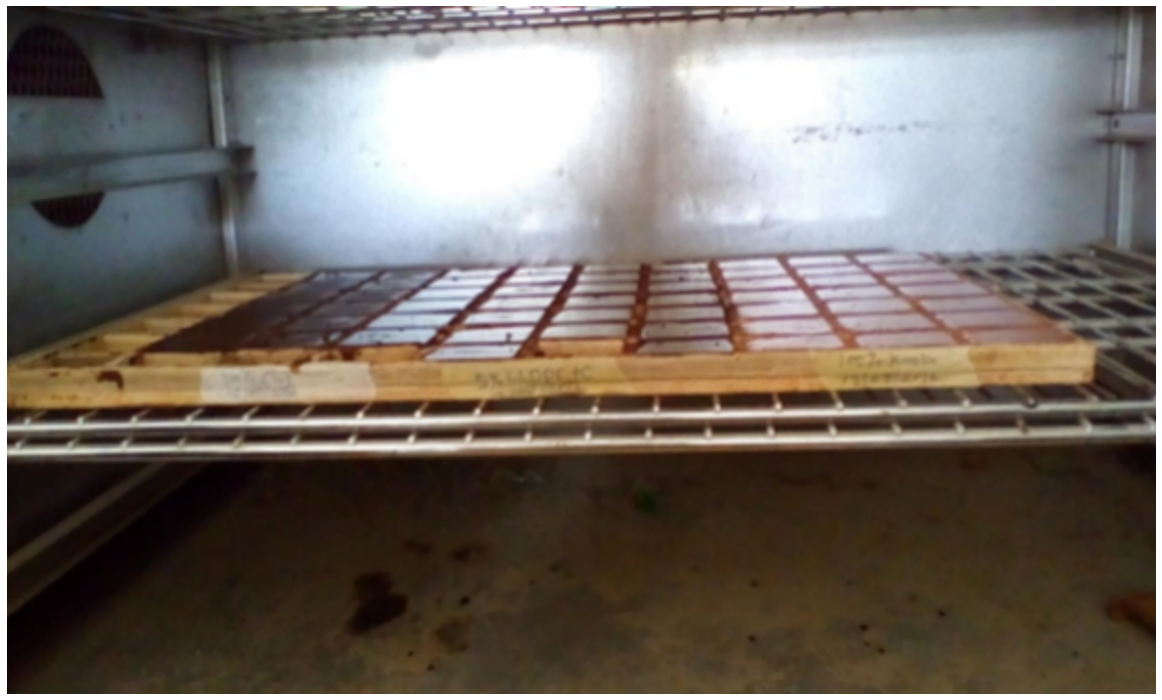
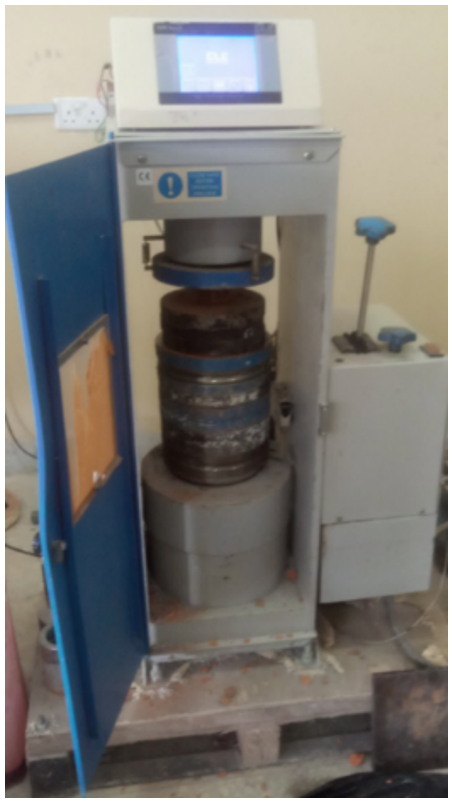


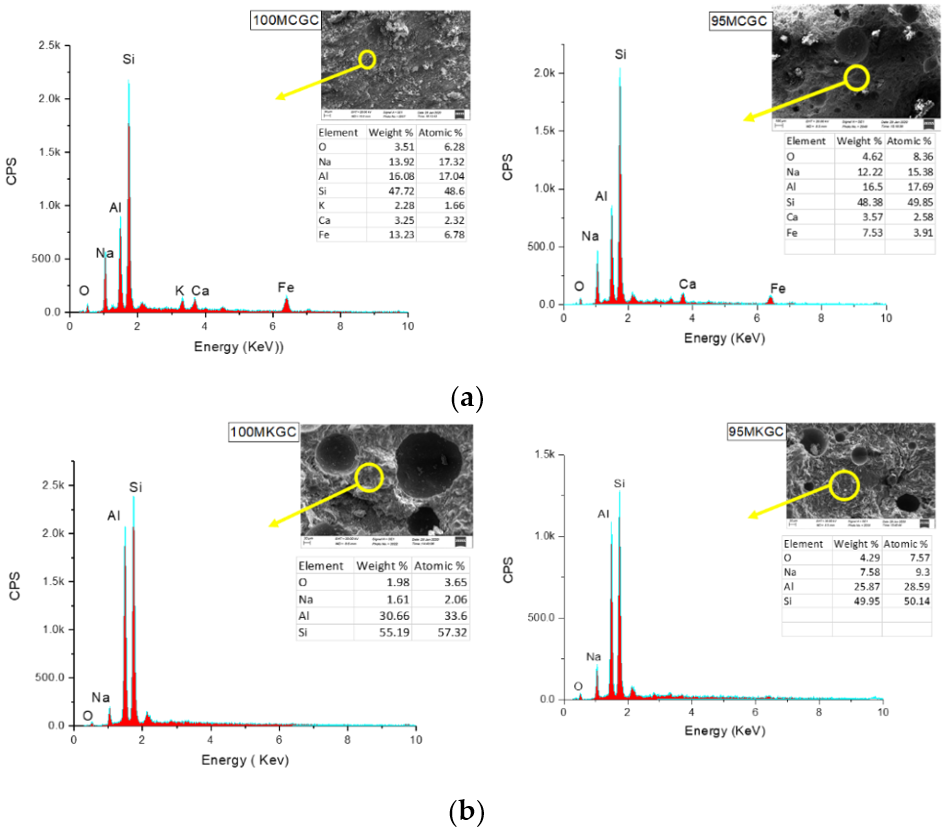
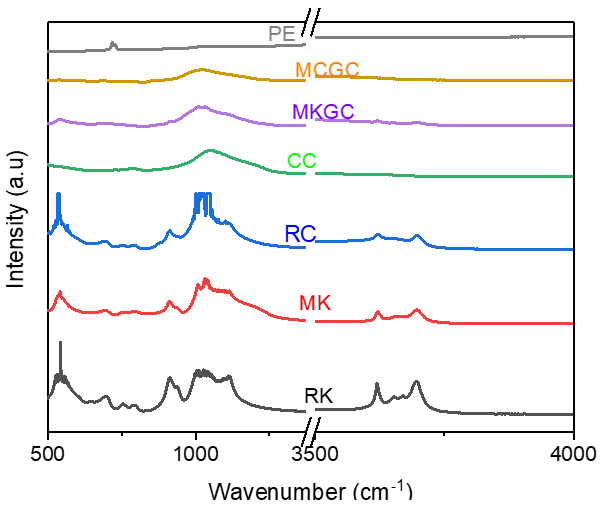


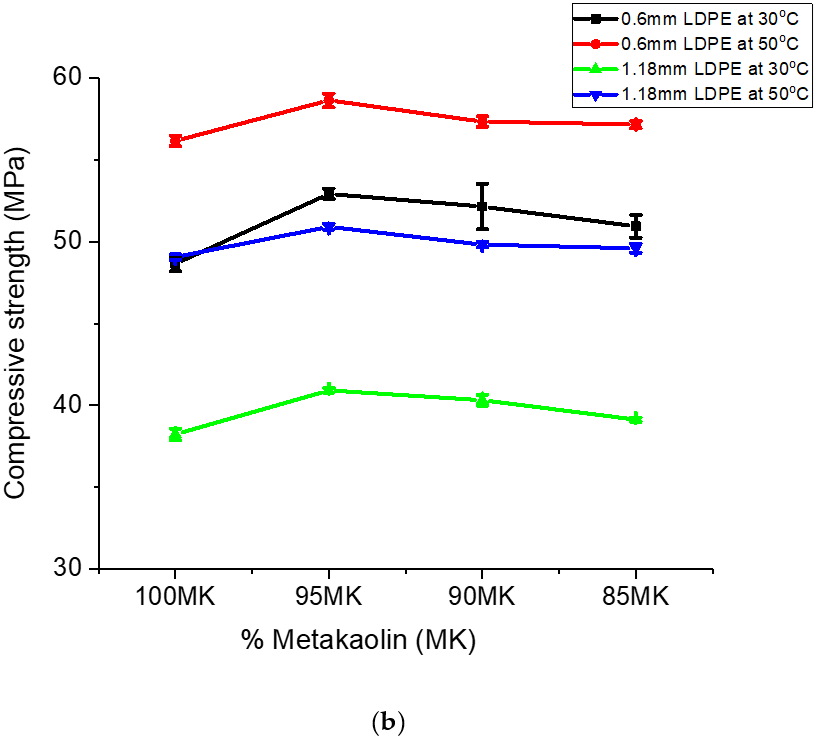
| Chemical Composition | Weight Percentage of MK (%) | Weight Percentage of MC (%) |
|---|---|---|
| Al2O3 | 43.24 | 20.67 |
| SiO2 | 52.06 | 54.44 |
| Fe2O3 | 1.15 | 9.44 |
| MgO | 2.04 | 4.94 |
| K2O | - | 2.76 |
| TiO2 | - | 1.06 |
| CaO | - | 0.66 |
| LOI | 0.3 | 1.7 |
| Sample | Variation in CS (MPa) at 0.6 mm | Variation CS (MPa) at 1.18 mm | ||
|---|---|---|---|---|
| ∆σ at 30 °C | ∆σ at 50 °C | ∆σ at 30 °C | ∆σ at 50 °C | |
| 100MCGC | 0.00 | 0.00 | 0.00 | 0.00 |
| 95MCGC | 5.65 | 5.81 | 2.68 | 1.86 |
| 90MCGC | 3.29 | 3.12 | 2.08 | 0.76 |
| 85MCGC | 2.97 | 1.82 | 0.90 | 0.54 |
| Sample | Variation in CS (MPa) at 0.6 mm | Variation CS (MPa) at 1.18 mm | ||
|---|---|---|---|---|
| ∆σ at 30 °C | ∆σ at 50 °C | ∆σ at 30 °C | ∆σ at 50 °C | |
| 100MKGC | 0.00 | 0.00 | 0.00 | 0.00 |
| 95MKGC | 4.26 | 2.47 | 4.51 | 1.81 |
| 90MKGC | 3.33 | 1.17 | 3.21 | 0.85 |
| 85MKGC | 2.27 | 0.99 | 1.37 | 0.11 |
| Sample | At 0.6 mm LLDPE | 1.18 mm LLDPE | ||||||||||
|---|---|---|---|---|---|---|---|---|---|---|---|---|
| 30 °C | 50 °C | 30 °C | 50 °C | |||||||||
| M1 (g) | M2 (g) | WA | M1 (g) | M2 (g) | WA | M1 (g) | M2 (g) | WA | M1 (g) | M2 (g) | WA | |
| (%) | (%) | (%) | (%) | |||||||||
| 100MCGC | 53.11 | 53.99 | 1.7 | 52.61 | 53.30 | 1.6 | 53.63 | 54.44 | 1.5 | 52.76 | 53.55 | 1.5 |
| 95MCGC | 52.78 | 53.52 | 1.4 | 53.47 | 54.27 | 1.5 | 53.39 | 54.08 | 1.3 | 52.53 | 53.21 | 1.2 |
| 90MCGC | 52.51 | 53.19 | 1.3 | 54.11 | 54.81 | 1.3 | 53.28 | 53.92 | 1.2 | 52.14 | 52.66 | 1.0 |
| 85MCGC | 52.12 | 52.59 | 1.0 | 53.26 | 53.79 | 0.9 | 52.21 | 52.73 | 1.0 | 52.12 | 52.53 | 0.8 |
| 100MKGC | 54.84 | 56.70 | 3.4 | 54.87 | 56.52 | 3.0 | 54.11 | 55.46 | 2.5 | 51.93 | 53.12 | 2.3 |
| 95MKGC | 56.49 | 57.85 | 2.4 | 52.39 | 53.65 | 2.4 | 54.00 | 55.24 | 2.3 | 53.73 | 54.86 | 2.1 |
| 90MKGC | 57.33 | 58.47 | 2.0 | 52.22 | 53.21 | 1.9 | 53.40 | 54.47 | 2.0 | 53.00 | 54.01 | 1.9 |
| 85MKGC | 57.59 | 58.74 | 2.0 | 52.37 | 53.31 | 1.8 | 53.35 | 54.36 | 1.9 | 52.43 | 53.27 | 1.6 |
Publisher’s Note: MDPI stays neutral with regard to jurisdictional claims in published maps and institutional affiliations. |
© 2021 by the authors. Licensee MDPI, Basel, Switzerland. This article is an open access article distributed under the terms and conditions of the Creative Commons Attribution (CC BY) license (https://creativecommons.org/licenses/by/4.0/).
Share and Cite
Linda Bih, N.; Aboubakar Mahamat, A.; Bidossèssi Hounkpè, J.; Azikiwe Onwualu, P.; Boakye, E.E. The Effect of Polymer Waste Addition on the Compressive Strength and Water Absorption of Geopolymer Ceramics. Appl. Sci. 2021, 11, 3540. https://doi.org/10.3390/app11083540
Linda Bih N, Aboubakar Mahamat A, Bidossèssi Hounkpè J, Azikiwe Onwualu P, Boakye EE. The Effect of Polymer Waste Addition on the Compressive Strength and Water Absorption of Geopolymer Ceramics. Applied Sciences. 2021; 11(8):3540. https://doi.org/10.3390/app11083540
Chicago/Turabian StyleLinda Bih, Numfor, Assia Aboubakar Mahamat, Jechonias Bidossèssi Hounkpè, Peter Azikiwe Onwualu, and Emmanuel E. Boakye. 2021. "The Effect of Polymer Waste Addition on the Compressive Strength and Water Absorption of Geopolymer Ceramics" Applied Sciences 11, no. 8: 3540. https://doi.org/10.3390/app11083540
APA StyleLinda Bih, N., Aboubakar Mahamat, A., Bidossèssi Hounkpè, J., Azikiwe Onwualu, P., & Boakye, E. E. (2021). The Effect of Polymer Waste Addition on the Compressive Strength and Water Absorption of Geopolymer Ceramics. Applied Sciences, 11(8), 3540. https://doi.org/10.3390/app11083540







